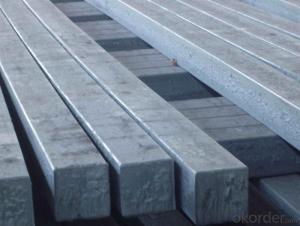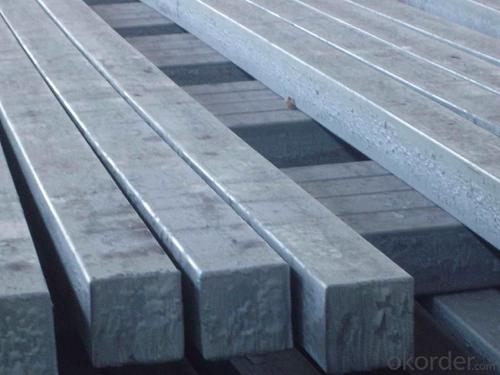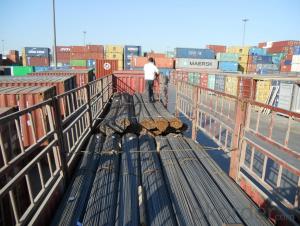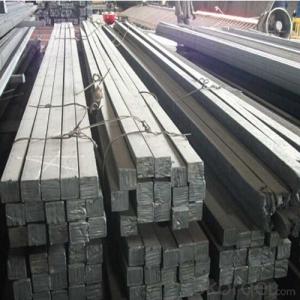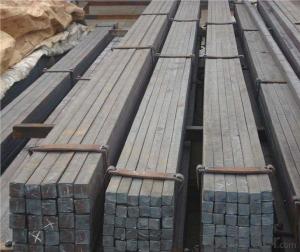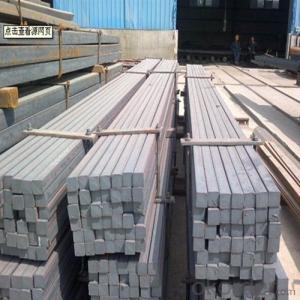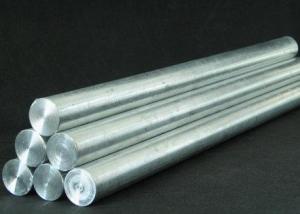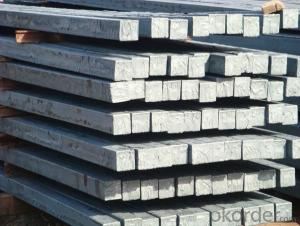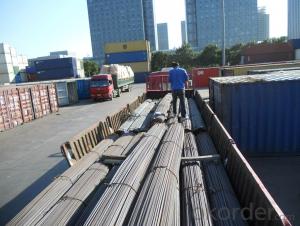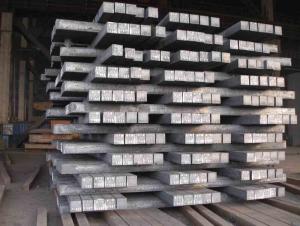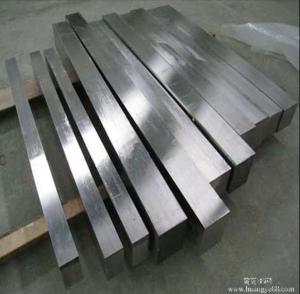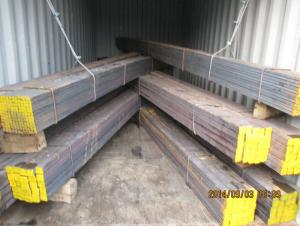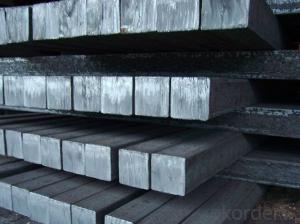Retangular And Square Steel Bar As Prime Material
- Loading Port:
- China main port
- Payment Terms:
- TT OR LC
- Min Order Qty:
- 25 m.t.
- Supply Capability:
- 10000 m.t./month
OKorder Service Pledge
OKorder Financial Service
You Might Also Like
Product Description
There are two types of Square Bar, one is hot rolled square bar and other one is cold drawn square bar. Our principal products is hot rolled square bar. We dedicate to products with material Q195 and Q235. We offer products with high quality and low price.
Specifications
-Standard: GB,
-Grade: Q195/Q235 or equivalent.
-Chemical Composition:
Standard | Grade | Element (%) | ||||
C | Mn | S | P | Si | ||
GB | Q195 | 0.06~0.12 | 0.25~0.50 | ≤0.050 | ≤0.045 | ≤0.30 |
GB | Q235B | 0.12~0.20 | 0.30~0.70 | ≤0.045 | ≤0.045 | ≤0.30 |
-Mechanical Properties:
Mechanical Properties | Grade | Steel diameter(mm) | |||
≤16 | 16~40 | 40~60 | 60~100 | ||
Yield Point Δs/MPa | Q195 | ≥195 | ≥185 | - | - |
Q235 | 235 | 225 | 215 | 205 | |
Tensile Strength | Q195 | 315~390 | |||
Q235 | 375~500 | ||||
Elongation δ5% | Q195 | ≥33 | ≥32 | - | - |
Q235 | 26 | 25 | 24 | 23 | |
Measures (Big measures):
(Section of Hot-rolled Square Steel Bar)
-Length of a side and Theoretical weight of Square Bar (Big measures).
Length of a side(mm) | Theoretical weight(kg/m) | Length of a side(mm) | Theoretical weight(kg/m) |
53 | 22.05 | 80 | 50.24 |
56 | 24.61 | 85 | 56.72 |
60 | 28.26 | 90 | 63.59 |
63 | 31.16 | 95 | 70.85 |
70 | 38.49 | 100 | 78.50 |
75 | 44.16 |
Notes:
1, The theoretical weights in the list, base on the density of 7.85 g/cm3.
2, Formula for theoretical weight of Square bar: a(length of a side) * a * 0.00785
3, The numbers with *mean that they are not regular or we don’t offer them.
-Regular length of Square Bar:
Steel | Length of a side (mm) | Length of steel (m) |
Normal steel | < 25 | 4~10 |
> 25 | 3~9 | |
Steel of high quality | All measure | 2~6 |
Tool steel >75 | 1~6 |
Usage/Applications
-The Square Steel is normally used as structure steel.
-Row material for other structure steel like steel angles, channels, I-beams, H-beams, etc…
-Row material for steel pipes.
Packaging & Delivery
-Packing Detail:
1, The products can be packed in bundles by steel wires.
2, The weight of each bundle no exceed normally 3 tons.
-Marks: We make tag marks and color marks for each bundle. The tag marks with white background and red company log will be tied up to each bundle. The information is usually including basic information of company and products like product name, specification, etc...and other information required by customers. As for color marks, we will paint both ends of each bundles to make sure that it will be more convenient for customers to distinguish theme from other products.
-Delivery Detail: 30~45 working days after receive buyer’s T.T. or L/C.
Payment:
-Invoicing on theoretical weight or actual weight as customer’s request.
-FOB, CFR or CIF.
-Regular terms of payment:
1, 30% payment in advance, the remaining balance (70% payment) against the copy of B/L.
2, 30% payment in advance, the remaining balance (70% L/C) against the copy of B/L.
3, Negotiable.
-The payment terms will be written in contraction detailed.
- Q: How do you use a steel square to determine the length of a hypotenuse?
- To use a steel square to determine the length of a hypotenuse, you can employ the Pythagorean theorem. By placing the steel square's shorter leg along one side of the right-angled triangle and aligning the longer leg with the other side, you can measure the lengths of the two sides. By squaring these lengths, adding them together, and then taking the square root of the sum, you can find the length of the hypotenuse.
- Q: Can a steel square be used for checking the plumbness of posts?
- No, a steel square is not typically used for checking the plumbness of posts. A level or a plumb bob is more commonly used for this purpose.
- Q: Can a steel square be used for creating perpendicular lines?
- Yes, a steel square can be used for creating perpendicular lines.
- Q: What are some common uses for a steel square in box joint construction?
- The steel square, a tool that is absolutely necessary for box joint construction, serves various purposes. Some common applications of the steel square in box joint construction are: 1. Marking and measuring: To precisely mark and measure the dimensions of the box joint, the steel square is employed. It aids in determining the appropriate size and spacing of the finger joints, guaranteeing accuracy in the layout. 2. Verifying squareness: In order to ensure that the corners of the box joint are perfectly perpendicular, the steel square is utilized. This verification guarantees that the joints are solid and robust. 3. Aligning and guiding: During the assembly of the box joint, the steel square can be used to align and guide the pieces together. It helps to maintain the correct angle and ensures that the joints fit tightly, resulting in a secure box. 4. Testing for flatness: Using the steel square, the flatness of the joint surfaces can be tested. By placing the square against the surfaces, any gaps or irregularities can be identified and corrected prior to final assembly. 5. Cutting and sawing: The steel square can serve as a guide for cutting and sawing the box joint. It provides a straight edge for the saw or router, ensuring precise and clean cuts along the joint lines. All in all, the steel square plays an indispensable role in box joint construction. It aids in layout, alignment, squareness verification, and precise cuts, leading to a well-fitted and sturdy box joint.
- Q: What are some common uses for a steel square in woodworking joinery?
- A steel square, also known as a framing square or carpenter's square, is a versatile tool used in woodworking joinery for a variety of purposes. Some common uses for a steel square include: 1. Measuring and marking right angles: The most basic use of a steel square is to ensure that corners and joints are perfectly square. Woodworking projects often require precise angles, and a steel square helps achieve accurate measurements and markings. 2. Checking for squareness: Before joining two pieces of wood together, it is crucial to check if they are square. A steel square is used to verify if the edges are at a perfect 90-degree angle, ensuring a tight and secure joint. 3. Laying out perpendicular lines: When marking cuts or making layouts, a steel square is invaluable in creating perpendicular lines. It helps ensure that cuts and joints are made at precise right angles, resulting in accurate and well-fitting pieces. 4. Determining and transferring angles: Steel squares often have additional markings that allow woodworkers to measure and transfer different angles. This feature makes them useful for creating miters, bevels, and other angled cuts or joints. 5. Checking for flatness: A steel square can also be used to determine if a surface is flat or level. By placing the square against the surface, woodworkers can identify any unevenness or deviations, allowing them to make necessary adjustments. 6. Acting as a saw guide: A steel square can be clamped or held firmly against the edge of a board, serving as a guide for a saw. This helps in making straight and accurate cuts, especially when working with handheld tools like circular saws or jigsaws. 7. Assisting in layout and design: Steel squares often have various measurements and markings etched onto them, making them helpful tools for layout and design work. Woodworkers can use the square to create proportional designs, take precise measurements, and establish consistent spacing. Overall, a steel square is an essential tool in woodworking joinery, enabling woodworkers to achieve accuracy, ensure squareness, and create well-fitting joints. Its versatility and reliability make it a staple in any woodshop, aiding in a wide range of tasks and contributing to the overall quality of woodworking projects.
- Q: Can a steel square be used for carpentry tasks?
- Yes, a steel square can be used for carpentry tasks. It is a versatile tool that can be used for measuring, marking, and checking angles in carpentry projects. Its durability and precision make it suitable for various tasks, such as laying out and cutting accurate angles, checking for squareness, and marking straight lines.
- Q: Can a steel square be used for checking the alignment of a jointer table?
- Certainly, a steel square has the capability to verify the alignment of a jointer table. This tool, known for its versatility, serves multiple purposes in woodworking, one of which is assessing the alignment of machinery. To evaluate the jointer table's alignment, simply position the steel square against both the fence and table of the jointer, ensuring absolute perpendicularity. This step will enable you to ascertain whether the jointer table is correctly aligned or necessitates adjustments. It is crucial to employ a top-notch steel square that guarantees precision and dependability for accurate outcomes.
- Q: How do you use a steel square to measure and mark 45-degree angles?
- In order to measure and mark 45-degree angles using a steel square, the following steps should be followed: 1. Begin by placing the steel square on the desired material, ensuring that one of the square's edges aligns with the material's edge. 2. Identify the 45-degree angle on the steel square. Typically, this angle is indicated by a diagonal line intersecting the 90-degree angle. 3. Align the steel square in a way that the diagonal line representing the 45-degree angle matches the material's edge. Also, ensure that the opposite edge of the square runs parallel to the material's opposite edge. 4. Once the steel square is correctly positioned, utilize a pencil or scribe to mark the material along the square's edge. 5. For utmost accuracy and precision, it is advisable to mark the angle on both sides of the material. This can be accomplished by flipping the steel square and repeating the procedure on the opposite side. By adhering to these instructions, one can proficiently utilize a steel square to accurately and consistently measure and mark 45-degree angles.
- Q: Can a steel square be used for deck railing layout?
- Yes, a steel square can be used for deck railing layout. A steel square is a versatile tool that can be used to measure and mark angles accurately, making it suitable for planning and positioning deck railing components.
- Q: How do you use a steel square to measure the height of a door?
- To use a steel square to measure the height of a door, place the square vertically against the door frame with the long side of the square flush against the floor. Adjust the square until the shorter side is perfectly aligned with the top edge of the door. Then, read the measurement on the long side of the square to determine the height of the door.
Send your message to us
Retangular And Square Steel Bar As Prime Material
- Loading Port:
- China main port
- Payment Terms:
- TT OR LC
- Min Order Qty:
- 25 m.t.
- Supply Capability:
- 10000 m.t./month
OKorder Service Pledge
OKorder Financial Service
Similar products
Hot products
Hot Searches
Related keywords
